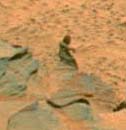One Mars photo that was not explained. This is no video dropout.
 This photo was taken by one of the Mars rovers. It was immediately debunked as a trick of light and Badastronomy.com explained that this was obvious in the stereo image. However, the stereo image, which we looked at, only confirmed that the object was an anomaly of the first order. The rover took no more photos of the object, or, if it did, they have not been released. If this is not a person in a heat-absorbing suit leaping to cover, then it must be a statue. It is not a trick of light, a video inclusion or anything other than what it appears to be. Graded A.
This photo was taken by one of the Mars rovers. It was immediately debunked as a trick of light and Badastronomy.com explained that this was obvious in the stereo image. However, the stereo image, which we looked at, only confirmed that the object was an anomaly of the first order. The rover took no more photos of the object, or, if it did, they have not been released. If this is not a person in a heat-absorbing suit leaping to cover, then it must be a statue. It is not a trick of light, a video inclusion or anything other than what it appears to be. Graded A.
read more